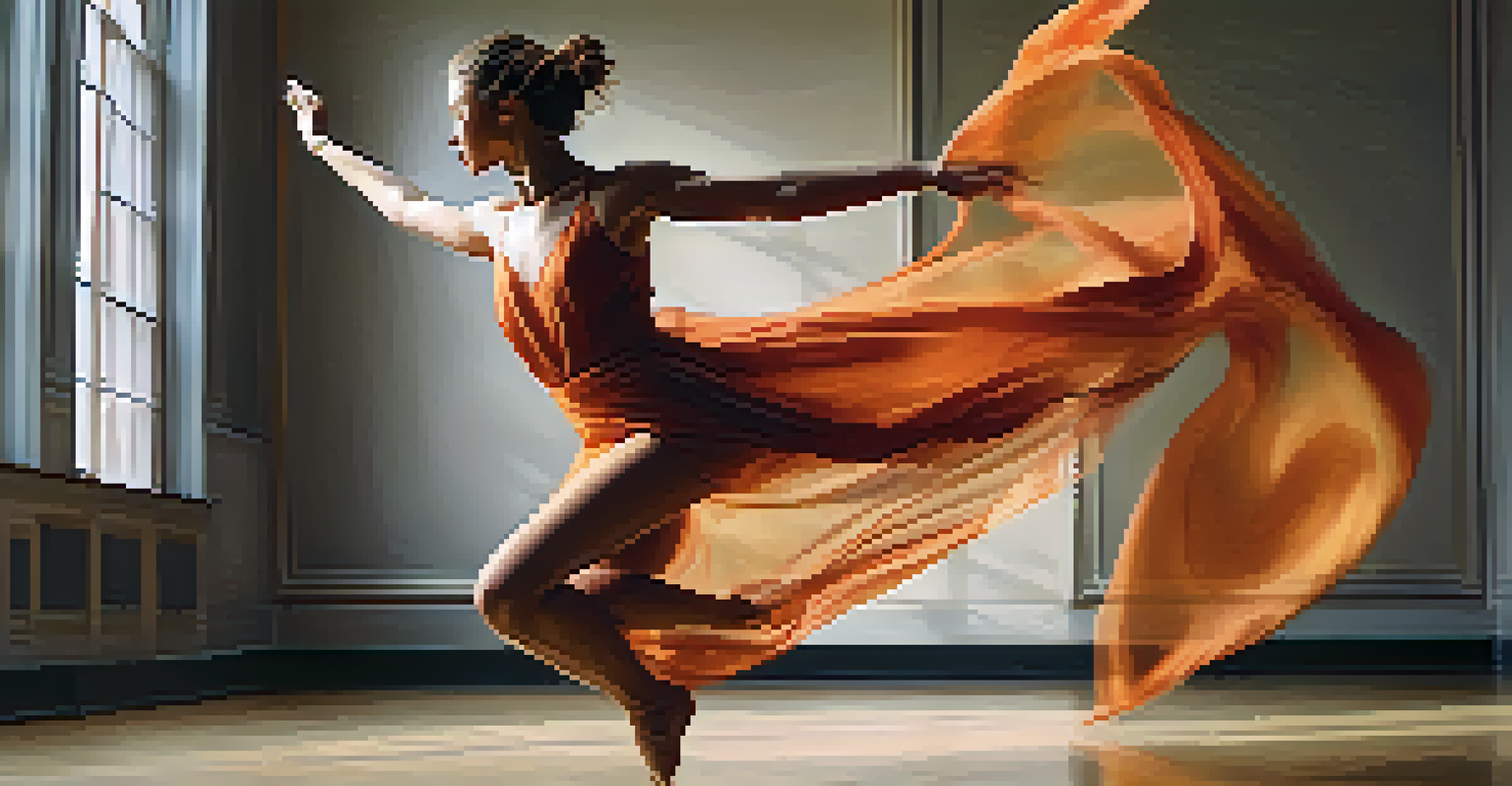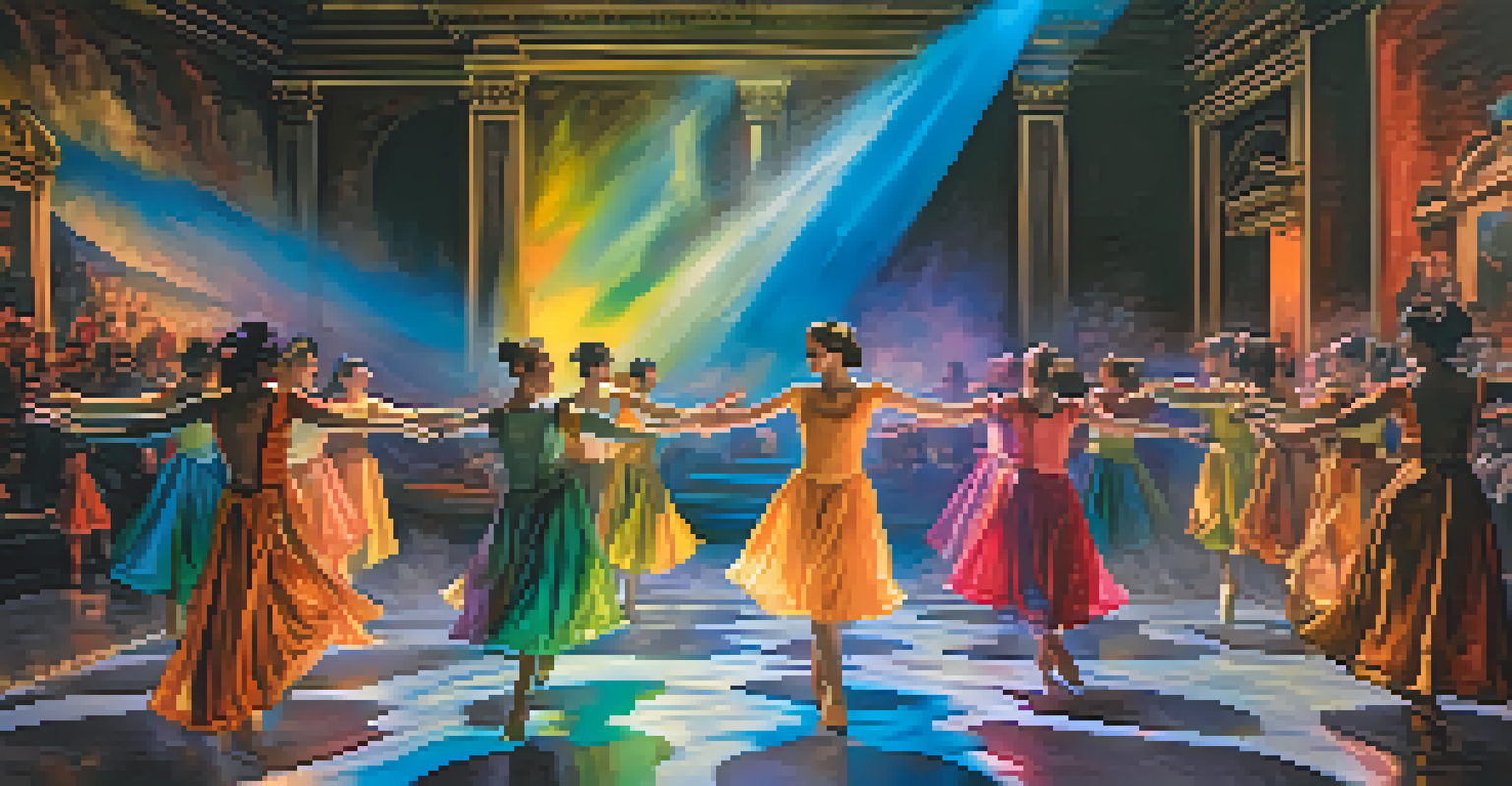From Canvas to Stage: Transitioning Painting into Dance Forms

Understanding the Connection Between Painting and Dance
At first glance, painting and dance might seem like two worlds apart. However, both art forms share a profound connection rooted in expression and creativity. Each stroke on a canvas can evoke emotions just as a dancer's movement can tell a story. By understanding this connection, artists can explore new ways to express their visions.
Dance is the hidden language of the soul.
Imagine a painting that bursts with colors and shapes; it tells a story even before you step back to appreciate it. Similarly, dance conveys emotion and narrative through movement and rhythm. When these two art forms intersect, they provide a rich tapestry for artists to explore and innovate.
As artists transition from one medium to another, they can start to see how the elements of painting—like color, form, and composition—can inspire choreography. This dialogue between the static and the dynamic creates a compelling narrative that captivates audiences.
The Role of Colors in Dance Interpretation
Colors play a crucial role in both painting and dance, influencing mood and perception. For instance, a vibrant red might evoke passion, while a tranquil blue can bring about calmness. Dancers can incorporate these colors into their costumes, lighting, and even the choreography itself, creating a visual symphony that resonates with the audience.

Think of a performance where the lighting shifts from warm oranges to cool blues as the music transitions. This color play can mirror the emotional journey depicted in a painting. By using color as a tool, dancers can enhance their performance, making it a multi-sensory experience.
Art Forms Intertwine Emotionally
Painting and dance are deeply connected through their shared ability to express emotions and tell stories.
Moreover, choreographers can draw inspiration from iconic paintings, translating color palettes into movement sequences. This not only adds depth to the performance but also creates a visual link to the artwork that inspired it.
Translating Shapes and Lines into Movement
Just as a painter uses shapes and lines to create form, dancers use their bodies to express similar concepts. The curvature of a line in a painting can be mirrored in the graceful arc of a dancer's arm. This translation from visual form to kinetic movement opens up a world of creative possibilities.
Every artist dips his brush in his own soul, and paints his own nature into his pictures.
Consider how a geometric painting might inspire a dance piece featuring sharp, angular movements. The dancers can embody the very essence of the shapes, creating a clear visual connection between the two art forms. This not only showcases the beauty of both but also emphasizes their interdependence.
Exploring the relationship between movement and form allows artists to push boundaries and experiment with new ideas. This fusion encourages a dialogue between the static nature of painting and the fluidity of dance, resulting in a compelling narrative.
Rhythm and Timing: The Heartbeat of Performance
Rhythm is a fundamental element in both painting and dance, albeit in different forms. In dance, rhythm is manifested through movement and music, while in painting, it can be observed through patterns and repetition. Understanding how rhythm works in each medium can enhance the overall experience for the audience.
Imagine a dancer moving in sync with a beat, each step echoing the rhythm of the music. This connection can be mirrored in painting through the use of repetitive patterns or brushstrokes that create a sense of flow. When these elements harmonize, they produce a captivating performance that draws viewers in.
Colors Enhance Dance Experience
The use of colors in dance, from costumes to lighting, can significantly influence the audience's emotional response.
As artists explore the rhythm inherent in both forms, they can create a seamless transition from canvas to stage. This exploration can serve as a powerful reminder of the interconnectedness of artistic expression.
Incorporating Narrative: Storytelling Through Art
Both painting and dance are powerful mediums for storytelling, allowing artists to convey complex narratives. Through visual imagery and movement, artists can engage audiences in a unique dialogue that transcends words. This storytelling aspect can be a driving force in merging the two forms.
For example, a dancer might perform a piece inspired by a narrative painting, bringing the scenes to life through movement. As the dancer interprets the artwork, the audience can visually and emotionally connect with the story being told. This synergy enriches the viewing experience.
By focusing on narrative, artists can create a cohesive performance that resonates deeply with audiences. This approach not only elevates the art forms but also fosters a greater appreciation for the emotional depth that both mediums can offer.
The Influence of Famous Artists on Dance Choreography
Throughout history, many renowned artists have influenced the world of dance. For instance, the works of Kandinsky and Matisse have inspired choreographers to create pieces that reflect their unique styles and philosophies. By studying these artists, dancers can explore how visual elements translate into movement and choreography.
Take the vibrant colors of Matisse's paintings; they can inspire choreographers to create lively and dynamic dance sequences that embody the essence of the artwork. This cross-pollination of ideas enriches both art forms and encourages innovation.
Narrative Links Art and Movement
Both painting and dance serve as powerful storytelling mediums, allowing artists to engage audiences through visual and kinetic narratives.
Moreover, bringing the essence of famous artworks into dance allows for a fresh perspective on both mediums. It encourages audiences to see familiar paintings through a new lens, fostering a deeper appreciation for the intricate relationship between visual and performing arts.
The Future of Art: Innovations in Combining Painting and Dance
As technology continues to evolve, so do the possibilities for merging painting and dance. With advancements in digital art and projection mapping, artists can create immersive experiences that blend visuals with choreography. This innovative approach opens up exciting new avenues for storytelling.
Imagine a performance where dancers move through projected landscapes, their movements interacting with visual elements on stage. This fusion not only captivates the audience but also challenges traditional boundaries between art forms. It invites viewers to engage in a multi-dimensional experience.

The future holds endless potential for artists willing to explore the intersection of painting and dance. By embracing innovation and collaboration, they can create groundbreaking performances that redefine the way we perceive both art forms.